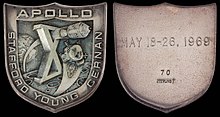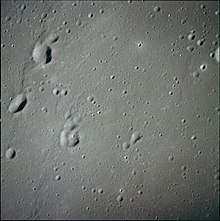Apollo 10
While NASA had considered attempting the first crewed lunar landing on Apollo 10, mission planners ultimately decided that it would be prudent to have a practice flight to hone the procedures and techniques.
Additionally, Apollo 10 set the record for the highest speed attained by a crewed vehicle: 39,897 km/h (11.08 km/s or 24,791 mph) on May 26, 1969, during the return from the Moon.
The mission's call signs were the names of the Peanuts characters Charlie Brown for the CSM and Snoopy for the LM, who became Apollo 10's semi-official mascots.
[10] However, Director of Flight Operations Christopher C. Kraft and others opposed this, feeling that new procedures would have to be developed for a rendezvous in lunar orbit and that NASA had incomplete information regarding the Moon's mass concentrations, which might throw off the spacecraft's trajectory.
Lieutenant General Sam Phillips, the Apollo Program Manager, listened to the arguments on both sides and decided that having a dress rehearsal was crucial.
Eisele was blackballed because of incidents during Apollo 7, which he had flown as CMP and which had seen conflict between the crew and ground controllers; he had also been involved in a messy divorce.
[22] These names were chosen by the astronauts with the approval of Charles Schulz, the strip's creator,[25] who was uncertain it was a good idea, since Charlie Brown was always a failure.
[27] But for Apollo 10, according to Cernan, "The P.R.-types lost this one big-time, for everybody on the planet knew the klutzy kid and his adventuresome beagle, and the names were embraced in a public relations bonanza.
[25] Stafford stated that, given the pins, "the choice of Snoopy [as call sign] was a way of acknowledging the contributions of the hundreds of thousands of people who got us there".
[31] The use of the dog was also appropriate since, in the comic strip, Snoopy had journeyed to the Moon the year before, thus defeating, according to Schulz, "the Americans, the Russians, and that stupid cat next door".
A CSM circles the Moon as an LM ascent stage flies up from its low pass over the lunar surface with its engine firing.
On the mission patch, a wide, light blue border carries the word APOLLO at the top and the crew names around the bottom.
They took part in the testing of the CSM at the Downey, California, facility of its manufacturer, North American Rockwell, and of the LM at Grumman in Bethpage, New York.
Craig Nelson wrote in his book Rocket Men that NASA took special precaution to ensure Stafford and Cernan would not attempt to make the first landing.
"[42] Mueller, NASA's Associate Administrator for Manned Space Flight, stated, There had been some speculation about whether or not the crew might have landed, having gotten so close.
[55] All appeared to be normal during the systems review period in Earth orbit, and the crew restarted the S-IVB third stage to achieve trans-lunar injection (TLI) and send them towards the Moon.
In addition to ALS-1, ALS-2, and ALS-3, the crew of Apollo 10 observed and photographed features on the near and far sides of the Moon, including the craters Coriolis, King, and Papaleksi.
[62] Shortly after the circularization burn, the crew partook in a scheduled half-hour color-television broadcast with descriptions and video transmissions of views of the lunar surface below.
[64] Stafford later commented that Cernan looked like he just came out of a chicken coop, and that the particles made them itch and got into the air conditioning system, and they were scraping it off the filter screens for the rest of the mission.
into a hot mic being broadcast live, which, combined with other language used by the crew during the mission, generated some complaints back on Earth.
The rest of the LM's ascent-stage engine fuel was burned to send it on a trajectory past the Moon and into a heliocentric orbit.
[79] After ejecting the LM ascent stage, the crew slept and performed photography and observation of the lunar surface from orbit.
[63] During their journey back to Earth, the crew performed some observational activities which included star-Earth horizon sightings for navigation.
[80] The crew fired the engine of the CSM for the only mid-course-correction burn required during the return trip at 188:49:58, a few hours before separation of the CM from the SM.
[63] Splashdown of the CM occurred about 15 minutes after reentry in the Pacific Ocean about 740 kilometres (400 nmi) east of American Samoa on May 26, 1969, at 16:52:23 UTC and mission elapsed time 192:03:23.
[88][89] In July 1969, Stafford replaced Alan Shepard as Chief Astronaut, and then became deputy director of Flight Crew Operations under Deke Slayton.
[90] In 1972, Stafford was promoted to brigadier general and assigned to command the American portion of the Apollo–Soyuz Test Project, which flew in July 1975.
[92] Charlie Brown's SM was jettisoned just before re-entry and burned up in the Earth's atmosphere, its remnants scattering in the Pacific Ocean.
[63] After translunar injection, the Saturn V's S-IVB third stage was accelerated past Earth escape velocity to become space debris; as of 2020[update], it remains in a heliocentric orbit.
In June 2019, the Royal Astronomical Society announced a possible rediscovery of Snoopy, determining that small Earth-crossing asteroid 2018 AV2 is likely to be the spacecraft with "98%" certainty.









